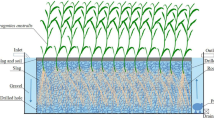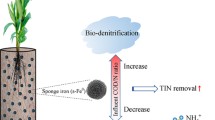Abstract
Contaminants from wastewater of aquaculture are increasing the risks of red tides in coastal areas. Such types of contaminants are difficult to remove by using conventional biological and ecological treatment methods because of the relatively low C/N ratios and the high salinity in coastal water ambience. Fe is considered a key element in natural chemical cycling and promotes the growth of animals and plants as well. The cycling of Fe ion combined with carbon, nitrogen, and phosphorus stimulates bacterial growth. As a result, it acts as a microbial carbon pump in coastal areas, such as natural wetlands, which have been activated and adapted to be salinity resistant and insufficient energy supply. Along these lines, in this work, constructed wetlands (CWs) with high ecological benefits and low cost of maintenance were used to treat aquaculture wastewater. The impact of Fe ion recycling on multiple contaminants was also systematically investigated. The two types of Fe dosage were pure ferrous ions and a mixture of iron powder and ferrous ions. After the application of a 3-day treatment, the dosage of iron powder/ferric ions (1:1 m/m) at a concentration of 15 mg L−1 showed a better effect, where the total nitrogen, total phosphorus, and chemical oxygen demand removal rates were increased by 2.95%, 2.16%, and 9.76%, respectively. From the microbial analysis, it was indicated that Fe ion affected the abundance and functions of the microbial communities in the CWs. The significant enrichment of Proteobacteria promoted the removal of multiple contaminants under saline stress and fixed carbon, and affected the whole microbe distribution and diversity in CWs. The implementation of such an environmentally friendly and economical approach arises as a promising candidate for the efficient removal of multiple contaminants from aquacultural wastewater in coastal zones.









Similar content being viewed by others
Data availability
The authors confirm that the data supporting the findings of this study are available within the article.
References
Akratos CS, Tsihrintzis VA (2007) Effect of temperature, HRT, vegetation and porous media on removal efficiency of pilot-scale horizontal subsurface flow constructed wetlands. Ecol Eng 29:173–191. https://doi.org/10.1016/j.ecoleng.2006.06.013
Asnicar F, Weingart G, Tickle TL, Huttenhower C, Segata NJP (2015) Compact graphical representation of phylogenetic data and metadata with GraPhlAn. PeerJ 3:1029. https://doi.org/10.7717/peerj.1029
Barat R, Montoya T, Seco A, Ferrer J (2011) Modelling biological and chemically induced precipitation of calcium phosphate in enhanced biological phosphorus removal systems. Water Res 45:3744–3752. https://doi.org/10.1016/j.watres.2011.04.028
Bechmann RK, Larsen BK, Taban IC, Hellgren LI, Møller P, Sanni S (2010) Chronic exposure of adults and embryos of Pandalus borealis to oil causes PAH accumulation, initiation of biomarker responses and an increase in larval mortality. Mar Pollut Bull 60:2087–2098. https://doi.org/10.1016/j.marpolbul.2010.07.010
Caporaso JG, Kuczynski J, Stombaugh J, Bittinger K, Bushman FD, Costello EK, Fierer N, Peña AG, Goodrich JK, Gordon JI, Huttley GA, Kelley ST, Knights D, Koenig JE, Ley RE, Lozupone CA, McDonald D, Muegge BD, Pirrung M et al (2010) QIIME allows analysis of high-throughput community sequencing data. Nat Methods 7:335–336. https://doi.org/10.1038/nmeth.f.303
Chang JJ, Wu SQ, Dai YR, Liang W, Wu ZB (2012) Treatment performance of integrated vertical-flow constructed wetland plots for domestic wastewater. Ecol Eng 44:152–159. https://doi.org/10.1016/j.ecoleng.2012.03.019
Cheng MQ, Li X, Jiao XX, Zhao ZM, Zhang YJ (2022) A critical review on iron-enhanced constructed wetland system: mechanisms and application scope. Water Air Soil Pollut 233:524. https://doi.org/10.1007/s11270-022-05985-z
Ding Y, Wang W, Song XS, Wang G, Wang YH (2014) Effect of spray aeration on organics and nitrogen removal in vertical subsurface flow constructed wetland. Chemosphere 117:502–505. https://doi.org/10.1016/j.chemosphere.2014.08.084
Glöckner FO, Kube M, Bauer M, Teeling H, Lombardot T, Ludwig W, Gade D, Beck A, Borzym K, Heitmann K, Rabus R, Schlesner H, Amann R, Reinhardt R (2003) Complete genome sequence of the marine planctomycete Pirellula sp. strain 1. Proc Natl Acad Sci USA 100:8298–8303. https://doi.org/10.1073/pnas.1431443100
Jiang YH, Chen YQ, Wang Y, Chen XM, Zhou XF, Qing KX, Cao WZ, Zhang YL (2023) Novel insight into the inhibitory effects and mechanisms of Fe(II)-mediated multi-metabolism in anaerobic ammonium oxidation (anammox). Water Res 242:12091. https://doi.org/10.1016/j.watres.2023.120291
Kemp PF, Aller JY (2004) Bacterial diversity in aquatic and other environments: what 16S rDNA libraries can tell us. FEMS Microbiol Ecol 47:161–177. https://doi.org/10.1016/s0168-6496(03)00257-5
Kumar MA, Choe JK, Lee W, Yoon S (2017) Synthesis of benzaldoxime from benzaldehyde using nanoscale zero-valent iron and dissolved nitrate or nitrite. Environ Nanotechnol Monit Manag 8:97–102. https://doi.org/10.1016/j.enmm.2017.06.003
Langille MGI, Zaneveld J, Caporaso JG, McDonald D, Knights D, Reyes JA, Clemente JC, Burkepile DE, Vega Thurber RL, Knight R, Beiko RG, Huttenhower C (2013) Predictive functional profiling of microbial communities using 16S rRNA marker gene sequences. Nat Biotechnol 31:814–821. https://doi.org/10.1038/nbt.2676
Liang Y, Zhu H, Bañuelos G, Yan B, Zhou QW, Yu XF, Cheng XW (2017) Constructed wetlands for saline wastewater treatment: a review. Ecol Eng 98:275–285. https://doi.org/10.1016/j.ecoleng.2016.11.005
Ma X, Zhou W, Fu Z, Cheng Y, Min M, Liu Y, Zhang Y, Chen P, Ruan R (2014) Effect of wastewater-borne bacteria on algal growth and nutrients removal in wastewater-based algae cultivation system. Bioresour Technol 167:8–13. https://doi.org/10.1016/j.biortech.2014.05.087
Malarvannan G, Kunisue T, Isobe T, Sudaryanto A, Takahashi S, Prudente M, Subramanian A, Tanabe S (2009) Organohalogen compounds in human breast milk from mothers living in Payatas and Malate, the Philippines: levels, accumulation kinetics and infant health risk. Environ Pollut 157:1924–1932. https://doi.org/10.1016/j.envpol.2009.01.010
Margesin R, Schinner F (2001) Potential of halotolerant and halophilic microorganisms for biotechnology. Extremophiles 5:73–83. https://doi.org/10.1007/s007920100184
McCarren J, DeLong EF (2007) Proteorhodopsin photosystem gene clusters exhibit co-evolutionary trends and shared ancestry among diverse marine microbial phyla. Environ Microbiol 9:846–858. https://doi.org/10.1111/j.1462-2920.2006.01203.x
McIntosh D, Fitzsimmons K (2003) Characterization of effluent from an inland, low-salinity shrimp farm: what contribution could this water make if used for irrigation. Aquac Eng 27:147–156. https://doi.org/10.1016/S0144-8609(02)00054-7
Muehe EM, Gerhardt S, Schink B, Kappler A (2009) Ecophysiology and the energetic benefit of mixotrophic Fe(II) oxidation by various strains of nitratereducing bacteria. FEMS Microbiol Ecol 70:335–343. https://doi.org/10.1111/j.1574-6941.2009.00755.x
Osaka T, Shirotani K, Yoshie S, Tsuneda S (2008) Effects of carbon source on denitrification efficiency and microbial community structure in a saline wastewater treatment process. Water Res 42:3709–3718. https://doi.org/10.1016/j.watres.2008.06.007
Pan F, Xu A, **a D, Yu Y, Chen G, Meyer M, Zhao D, Huang C-H, Wu Q, Fu J (2015) Effects of octahedral molecular sieve on treatment performance, microbial metabolism, and microbial community in expanded granular sludge bed reactor. Water Res 87:127–136. https://doi.org/10.1016/j.watres.2015.09.022
Park JY, Yoo YJ (2009) Biological nitrate removal in industrial wastewater treatment: which electron donor we can choose. Appl Microbiol Biotechnol 82:415–429. https://doi.org/10.1007/s00253-008-1799-1
Quaiser A, Ochsenreiter T, Lanz C, Schuster SC, Treusch AH, Eck J, Schleper C (2003) Acidobacteria form a coherent but highly diverse group within the bacterial domain: evidence from environmental genomics. Mol Microbiol 50:563–575. https://doi.org/10.1046/j.1365-2958.2003.03707.x
Ramette A (2007) Multivariate analyses in microbial ecology. FEMS Microbiol Ecol 62:142–160. https://doi.org/10.1111/j.1574-6941.2007.00375.x
Sakamoto M, Suzuki M, Umeda M, Ishikawa I, Benno Y (2002) Reclassification of Bacteroides forsythus (Tanner et al. 1986) as Tannerella forsythensis corrig., gen. nov., comb. Nov. Int J Syst Evol Microbiol 52:841–849. https://doi.org/10.1099/00207713-52-3-841
Tang SY, Liao YH, Xu YC, Dang ZZ, Zhu XF, Ji GD (2020) Microbial coupling mechanisms of nitrogen removal in constructed wetlands: a review. Bioresour Technol 314:123759. https://doi.org/10.1016/j.biortech.2020.123759
Tarayre C, De Clercq L, Charlier R, Michels E, Meers E, Camargo-Valero M, Delvigne F (2016) New perspectives for the design of sustainable bioprocesses for phosphorus recovery from waste. Bioresour Technol 206:264–274. https://doi.org/10.1016/j.biortech.2016.01.091
Thongtha S, Teamkao P, Boonapatcharoen N, Tripetchkul S, Techkarnjararuk S, Thiravetyan P (2014) Phosphorus removal from domestic wastewater by Nelumbo nucifera Gaertn. and Cyperus alternifolius L. J Environ Manag 137:54–60. https://doi.org/10.1016/j.jenvman.2014.02.003
Trevors JT (2010) Global pollution, climate change, and democracies. Water Air Soil Pollut 205:125–126. https://doi.org/10.1007/s11270-009-0251-1
VandeWalle JL, Goetz GW, Huse SM, Morrison HG, Sogin ML, Hoffmann RG, Yan K, McLellan SL (2012) Acinetobacter, Aeromonas and Trichococcus populations dominate the microbial community within urban sewer infrastructure. Environ Microbiol 14:2538–2552. https://doi.org/10.1111/j.1462-2920.2012.02757.x
Vymazal J (2007) Removal of nutrients in various types of constructed wetlands. Sci Total Environ 380:48–65. https://doi.org/10.1016/j.scitotenv.2006.09.014
Vymazal J (2011) Constructed wetlands for wastewater treatment: five decades of experience. Environ Sci Technol 45:61–69. https://doi.org/10.1021/es101403q
Wu X, Du YG, Qu Y, Du DY (2013) Ternary cycle treatment of high saline wastewater from pesticide production using a salt-tolerant microorganism. Water Sci Technol: a J Int Assoc Water Pollut Res 67:1960–1966. https://doi.org/10.2166/wst.2013.072
Bu XY, Dong SC, Mi WB, Li FJ (2019) Spatial-temporal change of carbon storage and sink of wetland ecosystem in arid regions, Ningxia Plain. Atmos Environ 204:89–101. https://doi.org/10.1016/j.atmosenv.2019.02.019
Xu P, Zeng GM, Huang DL, Feng CL, Hu S, Zhao MH, Lai C, Wei Z, Huang C, **e GX, Liu ZF (2012) Use of iron oxide nanomaterials in wastewater treatment: a review. Sci Total Environ 424:1–10. https://doi.org/10.1016/j.scitotenv.2012.02.023
Zhang Z, Jiang W, Peng K, Wu Z, Ling Z, Li Z (2023) Assessment of the impact of wetland changes on carbon storage in coastal urban agglomerations from 1990 to 2035 in support of SDG15.1. Sci Total Environ 877:162824. https://doi.org/10.1016/j.scitotenv.2023.162824
Zhao ZM, Song XS, Zhao YF, **ao YP, Wang YH, Wang JF, Yan DH (2017) Effects of iron and calcium carbonate on contaminant removal efficiencies and microbial communities in integrated wastewater treatment systems. Chemosphere 189:10–20. https://doi.org/10.1016/j.chemosphere.2017.09.020
Zhao ZM, Wang ZF, Cheng MY, Song XS, Cheng MQ, Zhang YJ (2020) Adding ferrous ions improved the performance of contaminant removal from low C/N coastal wastewater in constructed wetlands. Environ Sci: Water Res Technol 6:3351–3360 https://www.x-mol.com/paperRedirect/1323522279190269952
Funding
This work was supported by the National Key Research and Development Program of China (grant no. 2023YFC3208405); Open Foundation of Hebei Key Laboratory of Wetland Ecology and Conservation (grant no. hklk202201); and the National Natural Science Foundation of China (grant no. 51909157).
Author information
Authors and Affiliations
Contributions
All authors contributed to the study’s conception and design. Gao Xueqing, Yanqiu Liu, and Cheng Mengqi: conceptualization, former analysis, data curation, writing—original draft, project administration. Yinjiang Zhang and Zhufang Wang: former analysis. Zhao Zhimiao: resources, supervision, conceptualization, funding acquisition, writing—review and editing.
Corresponding author
Ethics declarations
Ethical approval
This work was performed in compliance with ethical standards.
Consent to participate
All authors were informed about and agreed to the protocol.
Consent to publish
All authors were allowed to read and approve the final manuscript.
Competing interests
The authors declare no competing interests.
Additional information
Responsible Editor: Diane Purchase
Publisher’s note
Springer Nature remains neutral with regard to jurisdictional claims in published maps and institutional affiliations.
Key points
• Fe ions promote the removal of multiple contaminants by triggering the cycling of C and N.
• Microbial diversity was improved and the functional bacteria Proteobacteria was obviously more abundant.
• The ability of Planctomycetes to carbon cycle anammox process was enhanced by the participation of Fe ions in coastal areas.
Rights and permissions
Springer Nature or its licensor (e.g. a society or other partner) holds exclusive rights to this article under a publishing agreement with the author(s) or other rightsholder(s); author self-archiving of the accepted manuscript version of this article is solely governed by the terms of such publishing agreement and applicable law.
About this article
Cite this article
Gao, X., Liu, Y., Cheng, M. et al. Investigating the addition of Fe for improving contaminant removal and regulating microbes in a simulated coastal wetland. Environ Sci Pollut Res 31, 42174–42184 (2024). https://doi.org/10.1007/s11356-024-33733-9
Received:
Accepted:
Published:
Issue Date:
DOI: https://doi.org/10.1007/s11356-024-33733-9




